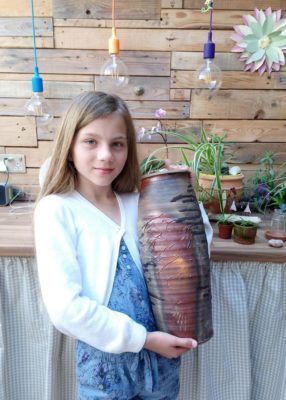David Kendall, Bernard Leach’s grandson, with a Korean-influenced teapot
The Leach Pottery is to launch a global centenary campaign to link people across the world via their favourite piece of pottery or ceramic art.
It’s the idea of Bernard Leach’s grand, great- and great-great grandchildren, and is due to be launched on Monday, 15th June.
A select number of the entries will be curated into a physical exhibition within the Cube Gallery at Leach Pottery, in St Ives, in 2021, or when safe to do so, to mark this unprecedented time in our history as well as to celebrate the pottery’s centenary.
Among those launching the campaign by sharing their own Pottery and People entries is Bernard Leach’s grandson, Philip Leach, who has been potting in North Devon for the last 41 years. He is joined by Jonny Nance, Damian Nance, David Kendall, and Sue Seymour.
Bernard’s great-grandchildren, including Helena Taylor and Jesse Leach, Jennie Kendall, Emma Leach, and Zoe Kendall, have also got involved. The team at the pottery are delighted to discover that the campaign has even engaged his great-great-grandchildren, including Anabelle Taylor.
Talented potter Phil Rogers, of Lower Cefnfaes Farm’s Marston Pottery, is also joining in. He recently featured on the BBC’s Bargain Hunt, showcasing a piece of ceramic art by Shoji Hamada. Found 20 years ago at an antiques fair in Builth Wells, Phil paid £2 for the pot, despite its worth reaching an estimated £500.
For the Leach Pottery People and Pottery campaign he stands proud with his favourite piece, another Shoji Hamada pot from around 1937, which shows the influence of Korean buncheong, a form of traditional stoneware.
Naturally, Bernard Leach’s descendants have pottery in their blood, and Phil is a professional potter, inspired artistically by the lush Welsh countryside in which he is based, but professional abilities are not required to engage in this campaign.
Objects to be entered into the showcase can be made by anyone and do not have to be a piece of Leach Ware Pottery or even a professional piece. This is a celebration of the art of all ceramics at all its levels, and in all its forms.
Elements to consider include who made the piece, or gifted it, where it was found or purchased, why it is so loved, who it belongs to, when it was acquired, inherited or received, when it was made, and what feelings it evokes. The piece may inspire nostalgia, happiness or even sadness. It might be perfectly imperfect with cracks or thumb marks, it might be reminiscent of a holiday, or particularly special person or animal.

Annabelle said: “This pot (above) was made by my Grandpa Clive Bowen, but we like to call him Grandpa Kiln. I like this pot because of the beautiful fish on the front, the texture, and its detail. This pot is anagama fired in Sven Bayer’s kiln, made in about 2000. I asked my Gamma and Grandpa Kiln about it and they say that it’s made from local clay mixed with Peters Marland clay.”
Phil Rogers said: “I have always been interested, and thereby influenced by, Korean pottery, particularly that of the 15th and 16th centuries. This pot that I am featured with above is by Shoji Hamada and was made fairly early in his career, probably around 1937. It shows the influence of Korean buncheong. I love it because it is so exuberant, with lively hakeme and an iron brush pattern that does not hold back. It is not at all hesitant or timid, just direct and powerful.”
Bernard Leach’s grandson, David Kendall, added: “This Korean influenced teapot is one of my favourite pieces and was made by my father at the Leach Pottery. I love the soft greys and also the beautiful floral decoration, so natural and fluid.
“Its perfectly balanced handle complements the cut fasted spout, and the lid detail is echoed in the fluting up the handle. So for me, this quiet, understated teapot is very special. I think its perfect form and elegance speak volumes about its simple beauty and eastern aesthetic.”
Leach Pottery director, Libby Buckley, said: “We are inviting people to consider why their favourite piece of pottery means so much to them — it could be a functional part of daily life, a mug that is used to enjoy a much-needed morning coffee, or it could be the sentimental gift that only comes out for special occasions. Whatever it is, we want to see and hear about it.
“We hope this creative campaign will make people stop and think about the connection they have with their pieces of artwork, whether functional or decorative. Pottery, and objects, can take on a different significance in different countries and cultures, and we’re hoping to see a truly global reaction and involvement in our Pottery and People campaign.
“We were so delighted when so many of Bernard Leach’s descendants agreed to help launch the campaign. It goes to show the impact that he has had on his family for many generations, which is wonderful to see. Long may this continue.”
For more detailed information about the Leach Pottery, Leach 100, or the Pottery and People campaign, visit leachpottery.com/ or email potteryandpeople@leachpottery.com.



